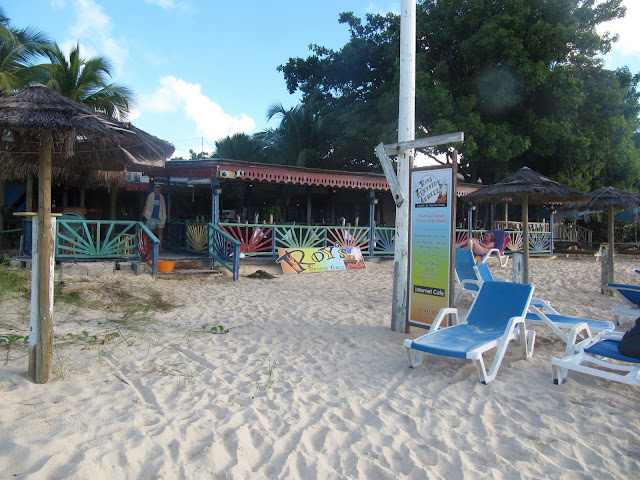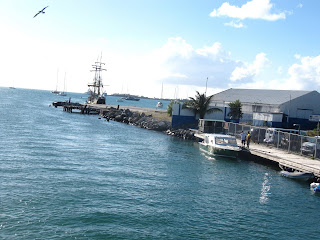Anguilla’s name (think middle syllable) refers to eels and it gets this name from its thin shape, 16 miles long and 3.5 miles at its widest point. Its capital is a village in a valley called “The Valley,” The island has about 16,000 citizens plus several thousand tourists in season. It boasts itself as the number one “destination wedding” place and we saw a billboard stating that tourism is our number one industry, and reminding residents to protect it – be nice to tourists. And they are. It also has, what else, a medical school.
Our short voyage from St. Maarten was fast fun but rather uneventful. We did make several tacks once rounding Anguillita, a tiny island at Anguilla’s western end. Road Bay is the only port of entry for boats.
Customs

is at the end of the dinghy dock.

Anguilla has a rather weird policy: Customs is free on the way in and on the way out, as long as you anchor in Road Bay. But to take a day trip (no overnight anchoring allowed except in one other bay right next to Road Bay) to anchor in the outer islands to snorkel for the day or visit any other of the beautiful bays that surround the island comes at a cost of $53.00US per day.

So we stayed in Road Bay which while quite rolly, and noisy at night because of the DJ at Elvis’ beach bar, was convenient. (and we're cheap...you think?) We are third boat from the left in this photo.

We chose to be further out (a three minute dinghy ride to town) instead of nearer to facilitate our planned 3:00 am departure – less other boats to dodge in the darkness.
The strip of land on which the customs office and about 12 restaurants are located is the village of Sandy Ground. Sandy Ground is actually a strip separating the bay, aqua water to left, from the salt flats, gray-green water to the right. From the flats, from the 1600s to the mid 1980’s, salt was extracted – back breaking labor.

While we were here Roger was reading a book called The Big Oyster, by Mark Kurlansky, which is a history of oysters and New York City and the relationship between them. While sitting at Roy’s Restaurant (free beach chair and wifi with expensive lunch),

he read that a community was formed on the south side of NYC’s Staten Island in New York by freed black people before the Civil War who were engaged in the oystering and strawberry growing industries, called Sandy Ground. Roger loves coincidences like this.
Anguilla has had an interesting recent history. Electricity was not introduced until the 1960s. England in its arrogance, had decided, when dismantling its empire to lump Anguilla with St. Kitts and Nevis. And the leader of St. Kitts, the largest of the three islands made statements about teaching the Anguillans who was boss. An armed revolution ensued in which the shots that were fired resulted in no deaths, and Anguilla was granted what it wanted, a relationship analogous to that of Puerto Rico to the US.

who loves his island and talking about it. He warned us that he would even be answering the questions that we did not ask and he was true to his word. He took us to two of the three huge luxury resorts in the western end of the island, facing St. Martin.
At CuisinArt,

which caters to families, the architecture reminded us of Santorini, and one of the restaurants there is so named.

Nice place with St. Martin in the background, about eight miles across the sea.
Cap Juluca has the loveliest beach and is the big destination wedding place. It is mostly villas, some with their own pools.

Don wanted to take us to Viceroy, the grandest of the three but we asked instead to see the east end of the island. We saw the fisherman's bay
with a restaurant that you can only get to by boat -- like Happy Island at Union Island.

We saw the home of the beloved former leader and were dropped at Shoal Bay for 45 minutes, with our consent so Don could take another fare. Is this a gorgeous beach or not?

Then more sights and lunch at the English Rose in The Valley, the capital of the island. Roger had stewed goat. Then a haircut by a Spanish speaking barber, a postcard, a stamp and Don took us back in time to check out of customs early the next morning, after a lovely sunset.

So we only spent two and half days here and enjoyed it. Posted from Virgin Gorda, BVI’s.




































